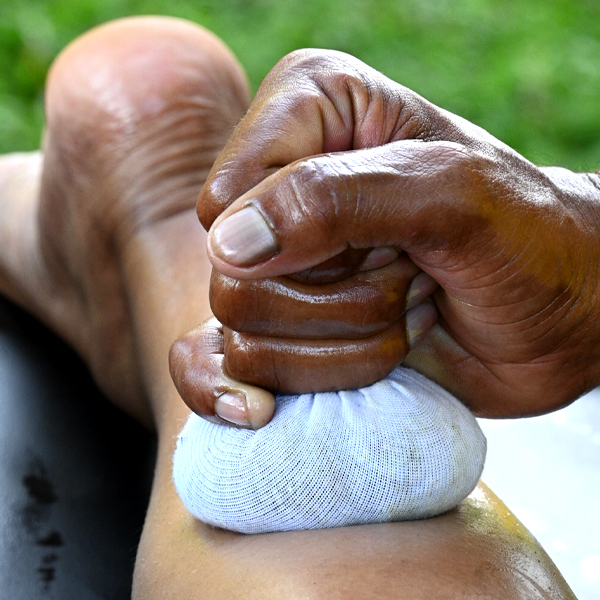Sciatica is a painful condition that occurs when the sciatic nerve, the largest nerve in the body, becomes irritated or compressed. This nerve extends from the lower back through the hips and down each leg, and when inflamed, it can cause intense pain, numbness, or tingling sensations. The discomfort can be mild or severe, often worsening with prolonged sitting or movement. Sciatica is not a disease itself but rather a symptom of an underlying condition, such as a herniated disc or spinal misalignment.

Causes of Sciatica (Gridhrasi)
Sciatica is commonly caused by compression or irritation of the sciatic nerve, which may result from herniated discs, bone spurs, spinal stenosis, or muscle inflammation. Poor posture, prolonged sitting, heavy lifting, or trauma to the lower back can also contribute to nerve irritation. In some cases, conditions like diabetes or piriformis syndrome—where a muscle in the buttocks compresses the sciatic nerve—can trigger symptoms. Understanding the root cause is essential for effective treatment and long-term relief.
From a conventional medical perspective, sciatica is primarily caused by structural issues such as herniated discs, spinal stenosis, degenerative disc disease, or spondylolisthesis. These conditions put pressure on the sciatic nerve, leading to pain and dysfunction. Lifestyle factors such as obesity, prolonged sitting, and lack of exercise can worsen nerve compression, increasing the risk of developing sciatica.
In Ayurveda, sciatica is referred to as "Gridhrasi", a condition caused by an imbalance in the Vata dosha (air and space elements). When aggravated, Vata leads to dryness and stiffness in the body, affecting nerve function. The blockage of energy channels (Srotas) by Ama (toxins) also plays a significant role. Excessive physical exertion, improper diet, or stress can aggravate the dosha imbalance, leading to pain and discomfort.
From an acupuncture perspective, sciatica is associated with blocked energy flow or Qi stagnation along the bladder and gallbladder meridians. Blockages may arise due to muscle tension, inflammation, or energy imbalances within the body's organ systems. Acupuncturists view sciatica as a symptom of an underlying disharmony, often linked to kidney or liver deficiency. External factors such as cold, dampness, and emotional stress can further disrupt the body’s energy balance, leading to sciatic pain.
Cure from Sciatica (Gridhrasi)
In conventional medicine, treatment involves pain relief medications, physical therapy, and epidural steroid injections to reduce inflammation. In severe cases, surgical intervention like microdiscectomy may be required to remove pressure on the nerve.
In Ayurveda, treatment focuses on Panchakarma therapies such as Abhyanga (therapeutic massage), Swedana (steam therapy), Kati Basti (oil pooling on the lower back), and Vasti (medicated enema therapy) to pacify Vata and remove toxins. Herbal remedies like Dashmool, Ashwagandha, and Guggulu are also recommended.
Acupuncture helps relieve sciatic pain by stimulating key points along the meridians, restoring energy balance, and reducing muscle tension. Techniques like cupping therapy, moxibustion, and electro-acupuncture are often used to enhance pain relief and improve nerve function.
Holistic healing – TARA Ayurveda and acupuncture combine treatments
A combination of Ayurveda and acupuncture offers a holistic and effective approach to treating sciatica by addressing both the root cause and symptoms. Ayurveda helps detoxify the body, correct dosha imbalances, and strengthen the musculoskeletal system, while acupuncture improves energy flow, reduces inflammation, and enhances nerve healing. Together, they provide long-lasting relief by reducing pain, improving mobility, and preventing recurrence. Studies suggest that patients receiving Ayurvedic therapies alongside acupuncture experience faster recovery and reduced dependency on painkillers. The synergy of these ancient healing systems offers a safe, natural, and sustainable solution for managing sciatica effectively.

